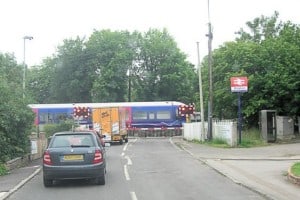Project: No dig track drainage renewal
Customer: Amey Colas Western, for Network Rail
Sector: Rail
Location: Midgham, Berkshire
The challenge
The client wanted to renew over 250m of track drainage at Midgham Station. It commissioned us to carry out a CCTV camera drainage survey of current system, and then asked us to submit a plan for a technical solution.
The key challenge was to complete the work with minimal disruption to both rail passengers and road users. A level crossing took an unclassified road crossed the railway line at the eastern end of the station. The crossing also provided the only access between the platforms.
Our CCTV track drainage survey showed that the pipe was intact under the level crossing, but collapsed five metres from it. It also showed the existing drainage falls were not self-cleansing. Some twin-wall pipes were partially or completely collapsed.
The conventional method for renewing the track drainage would have involved digging up the current drainage pipework, and installing new pipework. However, there were a number of buried services through the level crossing. These included foul and storm water sewers, a water main, telecommunication cabling, two electricity mains and control cables associated with the level crossing.
The presence of these services would have made excavation complex and time consuming. Trench digging by hand, re-bedding, replacement of the crossing surface and resurfacing of the road would have been needed, all under road closure and traffic management.
The solution
We recommended a no-dig solution that would not need a road closure and would cause less disruption for rail passengers. This was to retain and line the existing pipework.
Customer comment
“This method saved considerable cost when comparing the conventional dig and UV liner no dig solutions. The brilliance of this method is that it could be done on short notice NBS possessions with no road closure. We will be using this method again in the future.”
Mark Evill, Project Engineer, Amey Colas Western
Implementation
Ultra violet cure in place pipeline (CIPP) lining was used. This requires less equipment, less site set-up space, and less time to complete than conventional hot CIPP lining. Also, unlike the hot cure method, it creates no hazardous water waste.
The lining successfully reshaped the pipe and strengthened it, greatly reducing the risk of further collapses over the 70-year lifetime of the pipe renovation. The pipe was left as a carrier drain. However, at our suggestion, it was also turned into a water collector feed. This was achieved by sending a robot cutter along the length of the pipe to create drainage slots.
Results
The track renewal as a complete success. It was achieved with no road closures. Other advantages over conventional trackside drainage renewal were:
- No road closure
- Very little waste produced
- Minimal noise pollution
- 10% less emissions
- Less risk of track being affected
- 70-year design life
- Could be done using short no booked service (NBS) possessions


